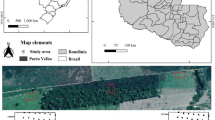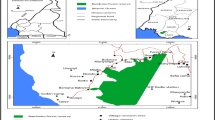Abstract
Declining soil fertility has become an increasingly urgent problem and gathering firewood is one of the important contributing factors. Due to the excessive exploitation of natural resources especially for firewood, the red soil hilly region has become one of the most vulnerable eco-environment regions in China. The pressure of gathering firewood on forestland soil fertility in forestland has been generally estimated by geographical information system and questionnaire method in this paper in the Zhuxi watershed of Changting County, Fujian Province, China, a typical representative in the red soil hilly region of China. The results of this study show that: i) Forestland soil fertility is negatively affected by gathering firewood, which is more intensive in the integrated buffer zone than out of zone. The forestland soil fertility grade, OM, total N, available N, total P, available P, total K, available K, pH and <2 μm clay content are lower and bulk density is higher in the integrated buffer zone than those out. ii) The forestland soil fertility grade, OM, total N, available N, total P, available P, total K, available K, pH and <2 μm clay content tend to be lower and bulk density tends to be higher in the village buffer zones than those out in Datian, Chenguang and Youfang respectively. iii) The population density, economic development and terrain might be the key driving forces contributing to the relationship between gathering firewood and forestland soil fertility. Higher population density leads to more massive firewood collection and imposes more pressure on forestland soil fertility. Decreasing the use of firewood stove may reduce firewood consumption and thus release the pressure of gathering firewood on forestland soil fertility. Terrain affects the accessibility to gathering firewood thus affects forestland soil fertility. Other driving forces influencing the relationship between gathering firewood and forestland soil fertility should also be taken into account in the further study.
Similar content being viewed by others
References
Aber JD, Melillo JM, McClaugherty CA, Eshleman KN (1983) Potential sinks for mineralized nitrogen following disturbance in forest ecosystems. Ecological Bulletins 35:179–192.
Biran A, Abbot J, Mace R (2004) Families and firewood: a comparative analysis of the costs and benefits of children in firewood collection and use in two rural communities in sub-Saharan Africa. Human Ecology 32(1):1–25.
Córdova-Aguilar H (1992) Firewood use and the effect on the ecosystem-a case study of the Sierra of Piura, Northwestern Peru. GeoJournal 26(3):297–309.
Cao X, Zhang G (1995) Formation and countermeasures of the vulnerable eco-environment of red soil hilly region. Rural Eco-environment 11(4):45–48. (In Chinese)
Chen G, Yu K, Liao L, Xu G (2000) Effect of human activities on forest ecosystems: N cycle and soil fertility. Nutrient Cycling in Agroecosystems 57(1):47–54.
Chen Z (1998) Desertification induced by water erosion and efforts to combat this erosion in Hetian Town in Changting County, Fujian Province. Progress Geography 17(2):65–70. (In Chinese)
Dass A, Sudhishri S, Lenka NK, Patnaik US (2011) Runoff capture through vegetative barriers and planting methodologies to reduce erosion, and improve soil moisture, fertility and crop productivity in southern Orissa, India. Nutrient Cycling in Agroecosystems 89(1):45–57.
Dovie DBK, Witkowski ETF, Shackleton CM (2004) The fuelwood crisis in Southern Africa-relating fuelwood use to livelihoods in a rural village. GeoJournal 60(2):123–133.
Gao Y, Zhong B, Yue H, Wu B, Cao S (2011) A degradation threshold for irreversible loss of soil productivity: a longterm case study in China. Journal of Applied Ecology 48(5):1145–1154.
Grinand C, Arrouays D, Laroche B, Martin MP (2008) Extrapolating regional soil landscapes from an existing soil map: Sampling intensity, validation procedures, and integration of spatial context. Geoderma 143(1):180–190.
Göl C, Dengiz O (2008) Effect of modifying land cover and longterm agricultural practices on the soil characteristics in native forest-land. Journal of Environmental Biology 29(5):667–682.
Hartter J, Boston K (2008) Consuming fuel and fuelling consumption: modelling human caloric demands and fuelwood use. Small-Scale Forestry 7(1):1–15.
Hegde R, Enters T (2000) Forest products and household economy: a case study from Mudumalai Wildlife Sanctuary, Southern India. Environmental Conservation 27(3):250–259.
Leach G, Mearns R (1988) Beyond the woodfuel crisis: people, land and trees in Africa. Earthscan Publications Ltd, London.
Kizilkaya R, Dengiz O (2010) Variation of land use and land cover effects on some soil physico-chemical characteristics and soil enzyme activity. Zemdirbyste-Agriculture 97(2):15–24.
Liu G, Jiang N, Zhang L, Liu Z (1996) Soil physical and chemical analysis and description of soil profiles. Standards Press of China, Beijing, China. (In Chinese)
Ndayambaje JD, Mohren GMJ (2011) Fuelwood demand and supply in Rwanda and the role of agroforestry. Agroforestry systems 83(3): 303–320.
Ogunkunle ATJ, Oladele FA (2004) Ethnobotanical study of fuelwood and timberwood consumption and replenishment in Ogbomoso, Oyo state, Nigeria. Environmental Monitoring and Assessment 91(1):223–236.
Pilbeam CJ, Mathema SB, Gregory PJ, Shakya PB (2005) Soil fertility management in the mid-hills of Nepal: practices and perceptions. Agriculture and Human Values 22(2):243–258.
Rennie JK, Singh NC (1996) Participatory research for sustainable livelihoods: a guidebook for field projects. Iisd Winnipeg, Canada.
Rowell DL (1994) Soil science: methods and applications. Longman Group Limited, Longman Scientific & Technical, New York, USA.
Sáe Silva IMM, Marangon LC, Hanazaki N, Albuquerque UP (2009) Use and knowledge of fuelwood in three rural caatinga (dryland) communities in NE Brazil. Environment, Development and Sustainability 11(4):833–851.
Shankar U, Hegde R, Bawa KS (1998) Extraction of non-timber forest products in the forests of Biligiri Rangan Hills, India. 6. Fuelwood pressure and management options. Economic Botany 52(3):320–336.
Stoorvogel JJ, Smaling EMA (1998) Research on soil fertility decline in tropical environments: integration of spatial scales. Nutrient Cycling in Agroecosystems 50(1):151–158.
Thomas E, Douterlungne D, Vandebroek I, Heens F, Goetghebeur P, Van Damme P (2011) Human impact on wild firewood species in the Rural Andes community of Apillapampa, Bolivia. Environmental monitoring and assessment 178(1):333–347.
Tian Y, Peng B, Xie T (2001) Opinion on red desertification and types of desertified land in China. Resources and Environment in the Yangtza Basin 10(4):380–384. (In Chinese)
Wang CC, Yang YS (2011) Review of research on mountainous ecological restoration based on farmer household livelihood evolution. Journal of Natural Resources 26(12):344–352. (In Chinese)
Yang X, Zhong B, Xie X (2005) Soil erosion and conservation in red-soil hill area. China Agricultural Press, Beijing, China. (In Chinese)
Zeng J, Zhong B (2002) Historical changes in strategies to control soil and water erosion in Changting County. Fujian Soil Water Conservation 14(4):37–39. (In Chinese)
Zhao QG, Xu MJ (2004) Sustainable agriculture evaluation for red soil hill region of Southeast China. Pedosphere 14(3):313–321.
Zou AP, Chen ZB, Chen LH (2009) Spatio-temporal variation of eroded landscape in typical small watershed in the hilly region of red soil: A case study of Zhuxihe Small Watershed in Changting County, Fujian Province. Science of Soil and Water Conservation 7(2):93–99. (In Chinese)
Author information
Authors and Affiliations
Corresponding author
Rights and permissions
About this article
Cite this article
Chen, Zq., Chen, Zb., Chen, Hb. et al. The relationship between forestland soil fertility and gathering firewood in the Zhuxi watershed in the red soil hilly region of China. J. Mt. Sci. 10, 75–83 (2013). https://doi.org/10.1007/s11629-013-2376-3
Received:
Accepted:
Published:
Issue Date:
DOI: https://doi.org/10.1007/s11629-013-2376-3




